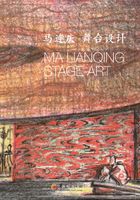
The Author's Words
Emptying the Space and Starting from Scratch
Ma Lianqing
Being initiated into model opera, I believe that most people of my age born in 1960s in China bear in their mind a theatrical complex since childhood. We used to fantasize to become the hero or heroine of the drama and wonder about the world of mystery behind the scenes. While today the space of the mysterious world has already become my spiritual home, the habitant of my soul—the theatrical space of stage art.
Time flies. I’ve been working on the stage art design for over 20 years. The past wonders and curiosities have turned into veneration and ponderings accompanying with occasional pains and helplessness. To tease out my creation of all these 20 years and publish them as a work collection may not count too much. But I just want to share the traces of my theoretical journey with all you like-minded readers because all behind-stories are different and worth remembering.
The process of stage art creation from designing to presenting, from beginning to end is like a parable for the circle of life. Passions and Ponderings of actors and actresses together with the applauses and flowers of the audiences converged in the theatre.However, no matter how stylistic, spectacular and dreamy they looked like, the settings and props would be dismantled ruthless and ended their lives in an unknown corner of the storehouse. It is just like a human being who have experienced the process from being born, growing up, maturing to fading and waiting for the rebirth,again and again. The theoretical art is just like the short-lived firework shining with great splendor and trans figured into a spiritual power which will stay much longer in our mind.
“Theatrical art has always been talking about life.” Every time when I read a new script, a new “blueprint” was formed in my mind which indicated a new circle of life we are going to experience in theatrical world and surely it will involve the process of transformation, nirvana, purgatory and rebirth. The theoretical world enables us to have access to different lives of empires and civilians, from heaven to earth. If we compare theatre as a world of fiction, the stage art designer can be regarded as the walking architect of this fictional world. Different from the other architects, the theoretical architects are intended to create a hypothetic poetic space by actualizing the fictional and spiritualizing the actual.
Fiction can be found everywhere in the theoretical space. It can be a ray of light,a heap of earth, a mottled wall, a string of notes or a sound of drums. The task of the stage art designer is to reconstruct all those elements into theatrical context and visualize them on the stage. Therefore, the work of the stage art designers are practical rather than theoretical for they have to think about how to convey the essence of the drama through theatrical languages, waiting for the judge and empathy from the audiences. However, there exists no sole criterion to the dramatic expression because “there are a thousand readers, there must be a thousand Hamlets.” In that sense, the drama can be regarded as a cross-culture communication about the meaning of life among the directors, designers, performers and the audiences. The stage art designer reconstructs the theatrical space and connects the drama with all the participants closely which constitute the essence of the theatrics.
Peter Brook once wrote in “The Open Door” that no matter what the theme of the drama is, people need to find the best way to live up them in theatre. The essence of the theatre lies in the present.
I usually describe my creative working as a process of emptying the space. To design in the empty space and ask myself “What am I going to design?” then try to make something out of nothing which is quite fundamental for me and maybe for all of the artists. The process is quite interesting because sometimes we need to stay hungry to pursue innovative self-realization as an independent artist with self-esteem; sometime we just pull away and ask more whys by putting ourselves in the audiences’ position.
The mentality and the sense of responsibility of the stage art designers play an important role in the context of theatrical space. Once the performance begins, even the wisest writers, directors and stage art designers should return to the backstage and leave the work to the audiences’ discretion. And amazingly enough, we also enjoy the happiness of our mind being “liven up” by the performers. We are lost in the moment of being attached, being felt and being expressed. Such enchantment proves the truth of Ming Cho Lee’s words: “The stage art designers should not live too much in themselves.”
The arrogant mentality, the thought inertia and the immersion in so-called past glories should be abandoned. We need to empty the space and start from the very beginning. Just as Peter Brook said, “People should empty their mind and return back to nothingness.”Past events have faded like a puff of smoke. The collection witnessed the ups and downs of my past 20 years and I am still on the road to empty the space and start from scratch.
